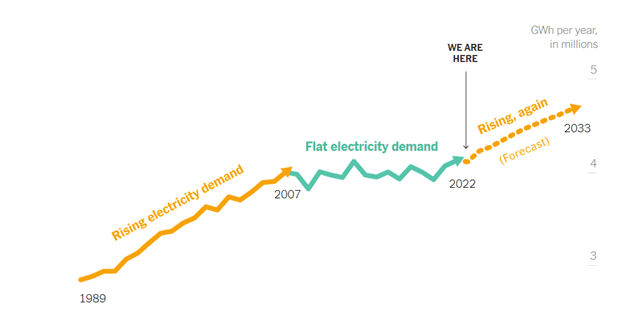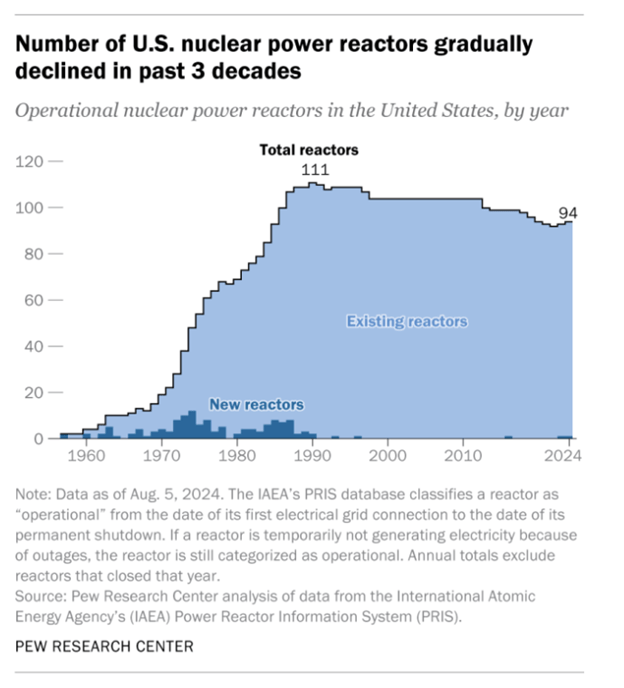Nuclear needs to play a bigger role in the clean energy future
Balancing nuclear energy for a resilient, sustainable grid
Electricity demand is surging across the U.S., driven by manufacturing growth and the proliferation of both data centers and cryptocurrency mining. At the same time, there’s growing pressure to reduce greenhouse gas (GHG) emissions by transitioning buildings, manufacturing, and transportation systems to electricity.
But renewables alone won’t meet this demand. Nuclear energy is rising as a critical option for a clean energy future, deserving stronger consideration in today’s energy portfolio. At West Monroe, we work with the largest utilities in the nation, navigating the complexities of grid resilience and clean energy mandates. We believe nuclear—particularly small modular reactors (SMRs)—will play a vital role in balancing the energy mix.
Why nuclear must be part of the energy mix
The U.S. grid is straining to meet growing electricity needs. Additionally, energy from renewable sources only accounts for 21% of total U.S. energy generation, with solar and wind combined making up the bulk. Nuclear energy remains an underutilized yet essential resource in this equation.
Source: NYTimes
While nuclear energy currently generates 20% of U.S. electricity, its carbon-free reliability makes it critical to achieving decarbonization goals. Advanced nuclear technologies like SMRs can complement intermittent renewables, ensuring a more resilient and sustainable grid.
West Monroe’s perspective on nuclear energy
We’ve seen nuclear energy make significant strides recently, evidenced by Constellation’s 20-year power purchase agreement with Microsoft, which includes restarting the Three Mile Island Unit 1 nuclear plant. The plant, decommissioned in 2019 for economic reasons, plans to be operational by 2028, pending necessary regulatory approvals. This project alone will add 835 megawatts of carbon-free energy to the grid. With states considering life extensions for existing nuclear plants, the potential role of SMRs is gaining momentum. We believe utilities and regulators must embrace nuclear energy more fully as part of a diverse energy strategy.
Key advantages of Small Modular Reactors (SMRs)
Small modular reactors represent the next near-term wave of nuclear technology, offering several key advantages over traditional central station nuclear power plants:
- Flexibility and scalability: SMRs are smaller and can be deployed incrementally, allowing utilities to scale capacity based on demand.
- Enhanced safety: Modern SMRs have advanced safety features, making accidents less likely and addressing public concerns.
- Cost-effectiveness: Factory-based construction reduces costs and improves quality control, making SMRs more affordable than traditional reactors.
- Geographical flexibility: SMRs can be sited in remote or smaller areas where traditional reactors wouldn't fit, supporting decentralized energy systems.
The unique attributes of SMRs make them an ideal solution for enhancing grid reliability while supporting carbon reduction goals. Integrating nuclear energy, particularly SMRs, into existing electric generation markets presents both opportunities and challenges in different market structures:
- Regulated State Markets: SMRs offer a stable, low-carbon power source that boosts grid reliability. However, balancing infrastructure investment with consumer protection requires careful consideration of rate impacts and cost recovery mechanisms.
- Deregulated Markets: SMRs provide a competitive advantage due to their scalability and lower upfront costs. Regulators and policymakers must address pricing strategies to align with customer demand and decarbonization objectives.
A balanced energy future requires a balanced approach with nuclear and renewables
To meet rising energy demand and ambitious decarbonization targets, utilities need a well-balanced resource portfolio. The energy mix should include nuclear, renewables like wind and solar, and energy storage solutions such as batteries. Currently, renewable energy accounts for 8% of the U.S. energy mix (21% of electricity generation), with nuclear providing steady baseload generation that ensures grid stability and complements the intermittent nature of renewables.
However, the number of U.S. nuclear power reactors has gradually declined in the past three decades, from 111 in 1990 to 94 in 2024.
Source: Pew
An integrated strategy is essential for maintaining frequency and voltage across the grid, allowing for a greater uptake of clean distributed energy resources while minimizing reliance on fossil fuels.
Perception of nuclear energy and barriers to nuclear acceleration
Public perception of nuclear energy remains a challenge, despite the advancements in safety and technology. A 2024 Pew survey shows just over half, or 56%, of Americans favor more nuclear power plants. Educating the public on the advancements in nuclear fuel storage and the safety protocols of SMRs is key to shifting this perception.
Nuclear energy faces challenges in regulatory approval, public perception, and financing. Streamlining the regulatory process and incentivizing private-public partnerships are critical to bringing more SMRs online. By addressing these barriers, utilities can integrate nuclear energy more seamlessly into their portfolios and accelerate the transition to a low-carbon future.
Nuclear needs a solid look from developers, investors, utilities, regulators, and consumers
The rising demand for electricity, coupled with the need to reduce carbon emissions, makes nuclear energy—particularly SMRs—a crucial component of the future energy mix. By leveraging both nuclear and renewable resources, utilities can build a more resilient, efficient, and sustainable energy system.
With our experience helping utilities navigate energy market shifts, West Monroe is uniquely positioned to support your organization in integrating nuclear energy into your portfolio. Our work with the largest utilities in the nation gives us unmatched insight into the evolving energy landscape. Whether you're focused on increasing resilience, complying with regulatory requirements, or driving decarbonization, we can help guide your strategy to success.



